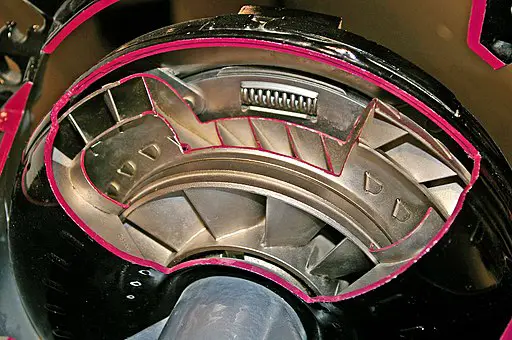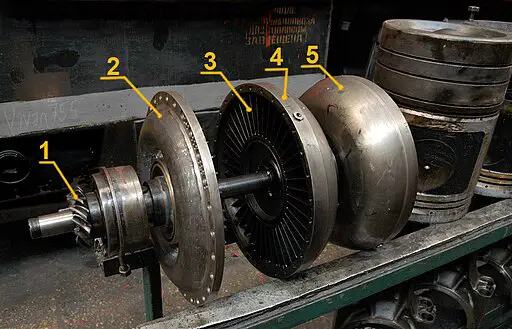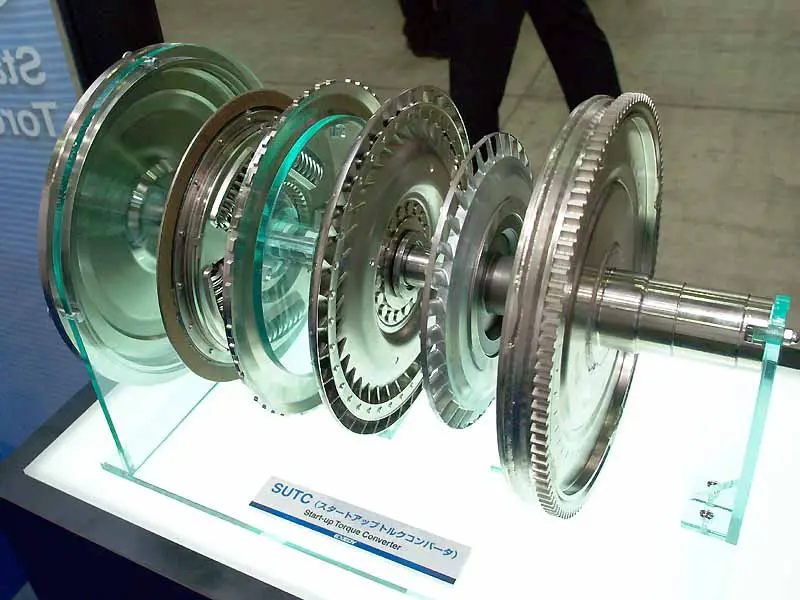Torque converter uses a lock-up clutch to transfer power more efficiently at higher speeds, while fluid coupling transmits power using fluid friction.
When it comes to transferring rotating power from an engine to a transmission, torque converters and fluid couplings play a crucial role. These hydrodynamic devices provide a smooth and efficient means of transmitting power, but they have distinct characteristics and functionalities that set them apart.
In this article, we will explore the key differences between torque converters and fluid couplings, understand how they work, and examine their advantages and applications. We will also dive into the efficiency of these devices and the technological advancements that have improved their performance over time.
Key Takeaways:
- Torque converters and fluid couplings are hydrodynamic devices used to transmit rotating mechanical power.
- While both converters and couplings utilize fluid, torque converters offer torque multiplication and adaptive reduction gear, while fluid couplings provide direct power transmission without torque multiplication.
- Torque converters are commonly used in automatic transmissions in automobiles, industrial power transmission, and marine propulsion systems.
- Fluid couplings find applications in various industrial power transmission systems.
- The choice between torque converters and fluid couplings depends on factors such as torque requirements, speed variability, load conditions, and space constraints.
How Torque Converters Work

Torque converters play a crucial role in transmitting torque from the engine to the transmission by utilizing the flow of fluid. Understanding the working of torque converters is essential to comprehend their efficiency and operation.
The main elements of a torque converter are:
- Impeller: This component is driven by the engine and is responsible for propelling the fluid within the torque converter.
- Turbine: The turbine is connected to the transmission and receives power from the fluid flow created by the impeller.
- Stator: Positioned between the impeller and turbine, the stator can alter the flow of oil within the torque converter.
The operation of a torque converter involves three distinct phases:
- Stall: During the stall phase, the impeller spins while the turbine remains stationary. This phase occurs when the vehicle is at a complete stop, and the torque converter facilitates the transfer of power from the engine to the transmission.
- Acceleration: As the vehicle accelerates, the impeller and turbine rotate at different speeds, resulting in torque multiplication. This phase allows for efficient power transfer and increased torque output.
- Coupling: In the coupling phase, the speed of the turbine reaches approximately 90% of the impeller’s speed. At this point, torque multiplication ceases, and the torque converter functions as a fluid coupling, facilitating direct power transmission.
The efficiency of a torque converter varies throughout its operation. The stall phase typically exhibits lower efficiency due to power losses, while the acceleration phase demonstrates higher efficiency as torque multiplication occurs. The design of the torque converter’s elements and the phases it goes through significantly impact its overall efficiency.
Advantages of Torque Converters
Torque converters offer several advantages in automotive applications.
1. Torque Multiplication
One of the main benefits of using a torque converter is its ability to provide torque multiplication during low-speed operation. This means that the torque output is increased, resulting in improved overall vehicle performance. Whether it’s accelerating from a stop or towing a heavy load, torque multiplication provided by the torque converter allows the engine to operate more efficiently and effectively.
2. Smooth and Gradual Power Engagement
Another advantage of torque converters is their ability to provide a smooth and gradual engagement of power. When starting the vehicle or shifting gears, the torque converter allows for a seamless transfer of power from the engine to the transmission. This reduces stress and wear on the transmission and drivetrain components, resulting in better longevity and durability.
3. Simple and Reliable Design
Torque converters have a simple and reliable design, which makes them suitable for various applications. They are composed of three main elements: the impeller, turbine, and stator. With fewer moving parts compared to other transmission components, torque converters are less prone to mechanical failures, ensuring reliable operation and reducing maintenance requirements.
4. Infinite Variability in Rotational Speed
One of the key features of torque converters is their ability to provide infinite variability in rotational speed. Unlike fixed-ratio mechanical gears, torque converters allow for a smooth transition between different speeds, providing optimal performance under varying load conditions. This adaptability enhances driving experience and improves fuel efficiency.
5. Lock-Up Function
Torque converters often include a lock-up function, which allows for the rigid coupling of the input and output, thus eliminating power losses associated with fluid flow. The lock-up function improves overall efficiency and reduces heat generation, resulting in better fuel economy. It is particularly beneficial during highway cruising when the vehicle operates at a consistent speed.
| Advantages of Torque Converters |
|---|
| Torque Multiplication |
| Smooth and Gradual Power Engagement |
| Simple and Reliable Design |
| Infinite Variability in Rotational Speed |
| Lock-Up Function |
Fluid Coupling Basics

5 — corps of compressor coupling
A fluid coupling is a two-element drive that uses hydraulic fluid to transmit rotating mechanical power. It consists of a pump wheel and a turbine wheel, contained within a housing. The pump wheel is connected to the input shaft, and the turbine wheel is connected to the output shaft.
When the input shaft rotates, the pump wheel imparts motion to the hydraulic fluid, which then transfers the motion to the turbine wheel, causing it to rotate and drive the output shaft. Fluid coupling operation relies on the flow of fluid, without any mechanical connection between the wheels.
Fluid couplings offer several characteristics and advantages, including:
- Slipping: Fluid couplings allow for a certain amount of slip, which enables smooth power transmission and adaptation to varying load conditions.
- Infinitely variable speed: Fluid couplings provide the ability to adjust and control the speed of the output shaft over a wide range.
- Limiting dynamic overloads: Fluid couplings can absorb and limit dynamic overloads, protecting the connected equipment.
Fluid couplings are commonly used in various industrial applications where smooth power transmission, speed control, and overload protection are required.
Differences Between Torque Converters and Fluid Couplings
Torque converters and fluid couplings are both types of hydrodynamic devices that use fluid to transmit power, but they have important differences. A torque converter is like a special kind of fluid coupling because it can multiply torque and adjust the gear. It has extra parts like a stator that helps to make more torque. On the other hand, a fluid coupling is simpler. It doesn’t multiply torque like a torque converter does.
When you need precise control over torque and to adjust to different loads, a torque converter is the better choice. But if you just need to transfer power directly without multiplying torque, a fluid coupling is more suitable. So, when deciding between the two, think about what your specific needs are for your application.
Applications of Torque Converters
Torque converters find applications in various industries and vehicles, offering versatile and efficient power transmission solutions. Let’s explore some of the key applications where torque converters are commonly used.
Automotive Industry
In the automotive sector, torque converters play a vital role in automatic transmissions. They are utilized in a wide range of vehicles, including cars, buses, trucks, and heavy-duty vehicles. Torque converters enable smooth power delivery, enhancing overall driving experience and performance.
Marine Propulsion
Marine torque converters are crucial components in boat and ship propulsion systems. They provide reliable torque transmission, ensuring efficient power delivery for smooth and controlled maneuvering in water. Torque converters enable marine vessels to navigate various water conditions with ease.
Industrial Power Transmission
Industrial torque converters are widely used in power transmission systems across industries. They find applications in a diverse range of equipment, including conveyor drives, forklifts, winches, drilling rigs, construction equipment, and railway locomotives. Torque converters provide the necessary torque multiplication and adaptability to handle different load conditions in industrial settings.
Here is a table summarizing the applications of torque converters:
| Industry/Application | Examples |
|---|---|
| Automotive | Cars, buses, trucks, heavy-duty vehicles |
| Marine Propulsion | Boats, ships |
| Industrial Power Transmission | Conveyors, forklifts, winches, drilling rigs, construction equipment, railway locomotives |
As evident from the table, torque converters have diverse applications, contributing to the efficient and reliable operation of various vehicles and equipment across industries.
Fluid Coupling Efficiency
Fluid coupling efficiency refers to how well a fluid coupling can transfer power from one shaft to another. Compared to mechanical drives, fluid couplings usually aren’t as efficient, but there are ways to make them work better.
New fluid couplings are designed with better materials and shapes for their parts to reduce power loss. Picking the right fluid and keeping it clean can also help. Even though they’re not as efficient as other options, fluid couplings are good at smoothly transferring power, protecting against overloads, and working well with different loads.
| Advantages of Fluid Couplings |
|---|
| Smooth power transmission |
| Overload protection |
| Adaptability to varying load conditions |
Torque Converter Technology Advancements
Torque converter technology has gotten much better lately to meet the need for cars that use fuel more efficiently and perform well. Manufacturers are using stronger materials and smarter designs to make torque converters lighter and more durable. They’re also shaping the inside parts of torque converters better to make them work smoother and waste less power.
New torque converters can be controlled by electronics, which helps them work even better. Some have more than one set of blades inside, which lets them adjust how much power they give out depending on how fast the car is going. Because of these changes, cars with modern torque converters use less fuel, drive more smoothly, and last longer.
Fluid Coupling Advantages
Fluid couplings offer several advantages in industrial applications. These advantages make them a cost-effective and efficient solution for power transmission in various industries.
Smooth Power Transmission
One of the main advantages of using a fluid coupling is its ability to smoothly transmit power. Unlike mechanical drives that can create shock and vibration during engagement, fluid couplings provide a seamless transfer of torque. This smooth power transmission helps to minimize wear and tear on the connected equipment, resulting in longer durability and reduced maintenance costs.
Overload Protection
Fluid couplings provide excellent overload protection by allowing the fluid to slip and absorb excessive torque. When the load exceeds the rated capacity, the fluid coupling allows the fluid to slip, preventing damage to the equipment and minimizing the risk of system failure. This overload protection feature ensures the safety and reliability of the power transmission system.
Variable Speed and Torque Control
Another advantage of using a fluid coupling is its ability to offer infinite variability in speed. By controlling the flow of fluid, the speed of the output shaft can be easily adjusted according to the application requirements. This variability in speed provides flexibility and enables precise control over torque delivery, allowing for efficient operation in various load conditions.
Simple Design and Reliable Operation
Fluid couplings have a simple design, consisting of two main elements – the pump wheel and the turbine wheel. This simplicity makes them reliable and easy to maintain. With fewer moving parts, fluid couplings have a lower risk of mechanical failure and require minimal maintenance. This simplicity also makes them cost-effective compared to more intricate power transmission systems.
Resistant to Shock Loads and High Torque Handling
Fluid couplings are designed to handle shock loads and high torque requirements. Thanks to the fluid medium, they can absorb and dissipate shock loads, preventing damage to the connected equipment. Additionally, fluid couplings can handle high torque values, making them suitable for demanding industrial applications where significant power transmission is required.
In summary, fluid couplings offer significant advantages in industrial power transmission systems. Their smooth power transmission, overload protection, variable speed and torque control, simple design, and ability to handle shock loads and high torque requirements make them a reliable and cost-effective choice for various industries.
Comparing Torque Converter and Fluid Coupling Efficiency
When comparing the efficiency of torque converters and fluid couplings, it is crucial to consider their specific characteristics and applications. Torque converters offer torque multiplication, which results in increased efficiency during low-speed operation. However, they may experience higher power losses compared to fluid couplings due to the presence of additional elements like the stator.
On the other hand, fluid couplings provide direct power transmission with minimal losses. Although they lack torque multiplication capabilities, they offer the advantage of efficient power transfer. The efficiency of both torque converters and fluid couplings can be further optimized through technological advancements, design enhancements, and proper maintenance.
Factors to Consider in Choosing Between Torque Converters and Fluid Couplings
When selecting between torque converters and fluid couplings, there are several factors to consider to make the right choice for your specific application:
1. Application Requirements
Consider the desired torque output, speed variability, and load conditions of your application. Torque converters offer torque multiplication, which is advantageous for applications requiring high torque at low speeds. Fluid couplings, on the other hand, provide direct power transmission without torque multiplication.
2. Transmission System
Determine whether your transmission system is automatic or manual, as this can impact the choice between a torque converter and a fluid coupling. Torque converters are commonly used in automatic transmissions, while fluid couplings are more suitable for manual transmissions.
3. Space Constraints
Evaluate the available space for installation. Torque converters typically require more space due to their additional elements like the stator. In applications with limited space, a fluid coupling might be a more compact option.
4. Cost
Consider the cost implications, including the initial investment and long-term maintenance requirements. Torque converters tend to be more expensive than fluid couplings due to their complex design and additional components.
5. Maintenance Requirements
Assess the maintenance demands of the torque converter or fluid coupling. While torque converters may require periodic maintenance, fluid couplings often have simpler maintenance requirements.
Consulting with experts or manufacturers can provide valuable insights into the most suitable option based on your specific needs. Each application has unique demands that should influence the selection process.
Conclusion
Torque converters and fluid couplings are two types of devices used for transferring power in machines. Torque converters are good at increasing torque and adjusting speed, which is useful for things like cars. On the other hand, fluid couplings simply transfer power without changing torque, which is better for some machines that don’t need speed adjustments. The choice between them depends on what the machine needs to do, like how much torque it needs and if it needs to change speed.
FAQ
What is a torque converter?
A torque converter is a type of fluid coupling that connects the prime mover to the automatic gear train in a vehicle with an automatic transmission. It transfers rotating power from the engine to the transmission, providing torque multiplication and adaptive reduction gear.
How does a torque converter work?
A torque converter utilizes the flow of fluid to transmit torque from the engine to the transmission. It consists of an impeller, turbine, and stator. The impeller is driven by the engine, while the turbine connects to the transmission. The stator alters the oil flow. Torque converter operation involves three stages: stall, acceleration, and coupling.
What are the advantages of torque converters?
Torque converters offer torque multiplication during low-speed operation, resulting in improved overall vehicle performance. They provide a smooth engagement of power, reducing wear and tear on transmission components. Torque converters are also versatile, allowing for infinite variability in rotational speed and adapting to changing load conditions. The lock-up function improves efficiency by eliminating power losses associated with fluid flow.
What is a fluid coupling?
A fluid coupling is a two-element drive that uses hydraulic fluid to transmit rotating mechanical power. It consists of a pump wheel and a turbine wheel, allowing for direct power transmission without torque multiplication capabilities.
What are the differences between torque converters and fluid couplings?
While torque converters are a type of fluid coupling, they provide torque multiplication and adaptive reduction gear. Torque converters include additional elements like a stator, which alters fluid flow to increase torque output. Fluid couplings, on the other hand, offer direct power transmission without torque multiplication.
Where are torque converters used?
Torque converters are commonly used in automatic transmissions of cars, buses, trucks, and heavy-duty vehicles. They are also utilized in marine propulsion systems, industrial power transmission, and other applications that require versatile torque handling.
How can fluid coupling efficiency be improved?
Fluid coupling efficiency can be improved by incorporating advanced design features, optimizing impeller and turbine blade shape and size, selecting the appropriate fluid, and performing proper maintenance.
What advancements have been made in torque converter technology?
Torque converter technology has seen advancements in materials, blade geometry, and fluid dynamics. Electronic control systems provide precise modulation of torque delivery and lock-up functionality. Some modern torque converters feature multiple turbines and stators to provide varying levels of torque multiplication.
What are the advantages of fluid couplings?
Fluid couplings offer smooth power transmission, overload protection, infinite variability in speed, and excellent torque control. They have a simple design, reliable operation, and are cost-effective for various industrial power transmission applications.
How do torque converter and fluid coupling efficiency compare?
Torque converters provide torque multiplication but may experience higher power losses compared to fluid couplings. Fluid couplings offer direct power transmission with minimal losses but lack torque multiplication capabilities. The choice depends on the specific requirements of the application and the desired balance between torque multiplication and efficiency.
What factors should be considered in choosing between torque converters and fluid couplings?
Factors to consider include the specific torque requirements, speed variability, load conditions, transmission type, space constraints, cost, and maintenance requirements.
What is the conclusion regarding torque converters vs fluid couplings?
Torque converters and fluid couplings are hydrodynamic devices with specific advantages and characteristics. Torque converters offer torque multiplication and adaptive reduction gear, while fluid couplings provide direct power transmission. The choice depends on the application requirements and the desired balance between torque multiplication and efficiency.
Image Credits
Featured Image By – Comyu, CC BY-SA 3.0 <http://creativecommons.org/licenses/by-sa/3.0/>, via Wikimedia Commons
Image 1 By – No machine-readable author provided. BerndB~commonswiki assumed (based on copyright claims)., CC BY-SA 3.0 <http://creativecommons.org/licenses/by-sa/3.0/>, via Wikimedia Commons
Image 2 By – Vivan755, CC BY-SA 3.0 <https://creativecommons.org/licenses/by-sa/3.0>, via Wikimedia Commons








